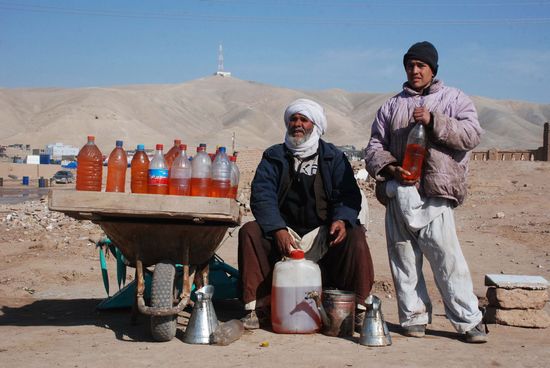In January 2011, on the outskirts of the city of Herat, Afghanistan, a father and son set up stalls on the roadside with trolleys and used food and beverage plastic barrels to sell petroleum products.

The morning news 10 years ago, the United States overthrew the Taliban regime in Afghanistan ruled by bin Laden. 10 years later, CNPC "captured" the first large-scale oil exploration agreement signed by the Afghan government for decades.
On November 28th, Afghanistan Minister of Mines Vasedura Shahrani and China National Petroleum Corporation signed a 25-year oil agreement in Kabul, the capital of Afghanistan.
Under the agreement, PetroChina will form a joint venture with the Watan Group in Afghanistan to jointly explore three oil fields located near the Amu Darya Basin. Afghanistan will share 70% of the project's net profit, and PetroChina will pay 15% of the oilfield use fee and 20% of the commercial tax.
The Afghan side expects that the oil reserves in the above-mentioned oil fields are estimated to be about 87 million barrels. If calculated at the price of US$100 per barrel, Afghanistan will receive about US$7 billion in revenue in the next 25 years.
According to the British "Financial Times" report, the Ministry of Mines and Minerals estimates that the oil field reserves in the oil field more than 80 million barrels, while the US Geological Survey estimates that the Amu Darya Basin also contains an additional 80 million barrels of oil reserves.
80 million barrels of oil is estimated to be equivalent to only six to seven thousandths of a thousandth of the oil and gas reserves in the Bohai Sea. In other words, for PetroChina, oil reserves are less attractive. The quality of crude oil in Afghanistan is not too high. China divides crude oil into light oil, medium oil I, medium oil II, and heavy oil according to its density. However, the above-mentioned Afghan oil field area belongs to medium-to-heavy oil I to heavy oil, which is of inferior quality.
Despite this, during the bidding process, PetroChina still tried to defeat the energy giants of countries such as Australia, Britain and Pakistan. According to an analysis by the Financial Times of the United Kingdom, the winning bid made CNPC in an advantageous position and could win bigger projects.
Since the Afghan government decided to open up mining rights for overseas investors in 2007, many international companies have begun to pay attention to this country that has experienced war for decades. Despite the lack of exploration, it is widely believed that the country’s mineral resources are abundant. The U.S. Geological Survey had stated in its 2006 report that Afghanistan has approximately 1.6 billion barrels of crude oil reserves and 16 trillion cubic feet of natural gas resources.
Li Weijian, director of the Center for West Asian Studies of the Shanghai Institute of International Studies, said in an interview with the Post-Morning newspaper that, from a geopolitical point of view, the mining of Chinese companies involved in Afghanistan is conducive to the stability of the surrounding areas. “This is more like a game of chess. Mineral resources are only one aspect. "Li Weijian used the previous Chinese companies' investment in Sudan, Iraq, and Kuwait as an example. At first, Chinese companies only exploited resources, but then they gradually involved in infrastructure construction, which is conducive to opening up the situation for Chinese companies in the future.
Xinhua Overseas Finance reported yesterday that PetroChina has agreed to set up a refinery. It is expected that the project will invest about 400 million U.S. dollars to create hundreds of jobs for the local people. If more oil reserves are discovered in the future, additional investments will be made.
The latest seizure of CNPC in Afghanistan is also the second largest cooperation agreement signed between China and Afghanistan. Prior to 2008, the Chinese metallurgical industry teamed up with Jiangxi Copper to win the 3.4 billion U.S. dollar Ainak copper mining right for the world-class Afghan deposit.
The Huffington Post of the United States had previously stated that the security of China’s energy assets held in various countries surrounding Afghanistan and the reliability of the pipeline connecting China will depend to a certain extent on the situation in Afghanistan. The gas sources of the Central Asian Gas Pipeline and the Second West-East Gas Pipeline come from the Amu Darya gas field in Turkmenistan.
Wooden Effect Powder,Wooden Effect Powder Coating,Epoxy Polyester Powder Coating
Special Effect Powder Coating,Metallic Powder Coating Co., Ltd. , http://www.cdpowdercoating.com